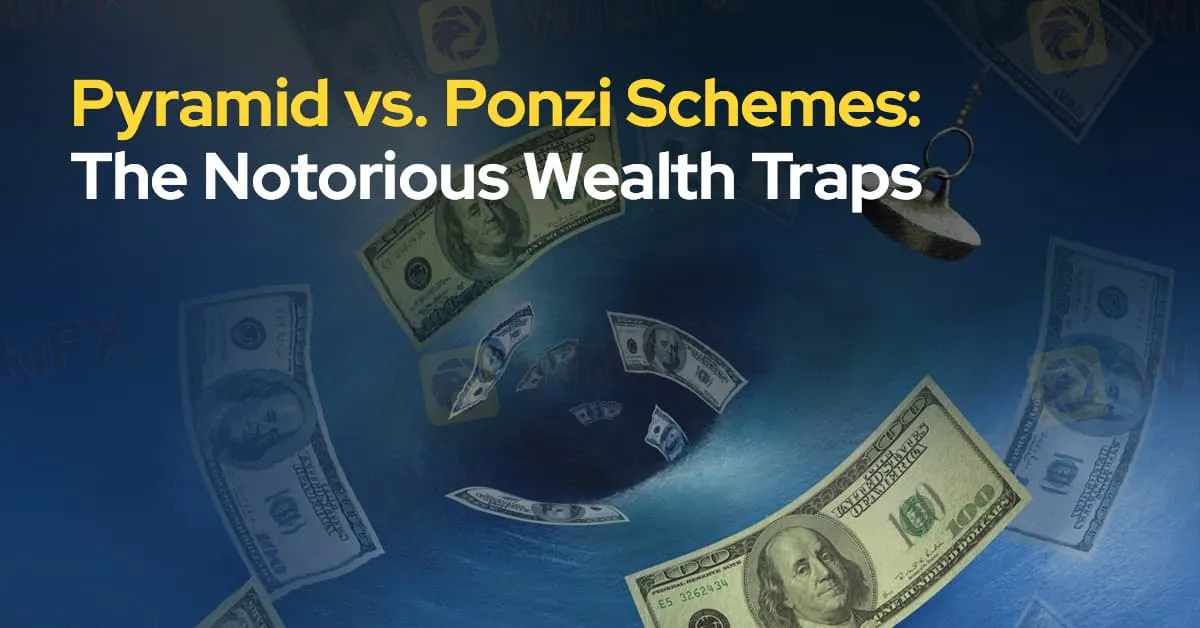简体中文
繁體中文
English
Pусский
日本語
ภาษาไทย
Tiếng Việt
Bahasa Indonesia
Español
हिन्दी
Filippiiniläinen
Français
Deutsch
Português
Türkçe
한국어
العربية
Pyramid vs. Ponzi Schemes: The Notorious Wealth Traps
Abstract:Two of the most notorious frauds are the pyramid scheme and the Ponzi scheme. Understanding these differences is essential for avoiding these traps and recognizing the red flags of financial fraud.

In the world of finance, there are schemes that promise riches and success, but often leave participants with nothing but loss. Two of the most notorious frauds are the pyramid scheme and the Ponzi scheme. Both exploit trust and thrive on deception, yet while they share similarities, they also have significant differences that set them apart. Understanding these differences is essential for avoiding these traps and recognizing the red flags of financial fraud.

At their core, both pyramid and Ponzi schemes rely on the same principle: using new investors money to pay off earlier participants. They often lure people in with the promise of high returns in a short amount of time, creating the illusion of a legitimate and profitable enterprise. However, neither structure generates any real profits. The payouts depend solely on the continuous recruitment of new participants or fresh investments, making them inherently unsustainable. When the flow of new participants slows down, both schemes quickly collapse, leaving the majority of people with significant financial losses.

A pyramid scheme primarily focuses on recruitment. Participants are required to pay an entry fee or invest in a product, with the promise of earning commissions based on recruiting new members. As new recruits join and pay their fees, a portion of the money flows upwards, benefiting those higher in the pyramid. The incentive to recruit becomes the primary driver of the scheme, with little to no emphasis on actual products or services being sold. Over time, the pool of potential new recruits dries up, causing the pyramid to crumble.

Ponzi schemes, on the other hand, focus on fraudulent investment opportunities. Here, a central figure or entity promises consistent, often outrageously high returns. Early investors may indeed receive payouts, but these payments come directly from the funds of new investors. The scheme is kept alive by continuing to attract fresh capital. Unlike pyramid schemes, Ponzi participants are not required to recruit others. Instead, they are led to believe their money is being invested in legitimate ventures, while in reality, its being used to keep up the façade. Eventually, when there aren't enough new investors to cover withdrawals, the scheme collapses.

The key distinction between the two lies in their structure. Pyramid schemes are heavily recruitment-focused, relying on a growing base of participants to sustain payouts, while Ponzi schemes hinge on the deception of a centralized operator pretending to invest funds. In pyramid schemes, individuals are encouraged to recruit others to earn money. In contrast, Ponzi schemes do not require recruitment from participants; instead, they believe their returns come from legitimate investments.
Despite the numerous legal crackdowns, these schemes continue to reappear, often disguised under different names or dressed up as “multi-level marketing” or “high-return investment” opportunities. They persist because they exploit the human desire for quick wealth and capitalize on the trust and greed that can cloud judgment.
In both cases, the outcome is the same: the majority lose money, while only a few at the top of the scheme profit—until the system inevitably collapses. The lesson? If an opportunity seems too good to be true, it probably is. Recognizing the telltale signs of both pyramid and Ponzi schemes can save you from becoming the next victim of financial fraud.

Disclaimer:
The views in this article only represent the author's personal views, and do not constitute investment advice on this platform. This platform does not guarantee the accuracy, completeness and timeliness of the information in the article, and will not be liable for any loss caused by the use of or reliance on the information in the article.
Read more

New Year’s First Trade KOL Posting Challenge
Start the year with a bang and showcase your forex trading prowess in the New Year’s First Trade KOL Posting Challenge hosted by WikiFX! This exciting opportunity is designed specifically for Key Opinion Leaders (KOLs) who are ready to lead their teams and engage their followers in the world of forex trading.

Indonesia officially joins the BRICS countries
Indonesia's decision to join the BRICS group will not only enhance economic cooperation within BRICS countries but is also expected to have a profound impact on global trade, investment, and the currency system.

Attention! Goldman Sachs Cuts Gold Target to $2910
As the Fed slows rate cuts, gold's price growth may be limited. Goldman Sachs revised its short-term forecast, expecting gold to reach $3,000 per ounce by mid-2026.

Inflation Rebounds: ECB's Big Rate Cut Now Unlikely
German inflation has surged once again, exceeding the 2% target for the second consecutive time. The overall inflation rate for the Eurozone, which is expected to be released on Tuesday, is also likely to show a slight increase, diminishing expectations for a large interest rate cut by the European Central Bank (ECB).
WikiFX Broker
Latest News
Ghana Trader Jailed for $300K Forex and Crypto Scam
US Dollar Surge Dominates Forex Market
Hong Kong Police Bust Deepfake Crypto Scam Syndicate Involving $34 Million
Is it a good time to buy Korean Won with the current depreciation?
Pepperstone Sponsored the "Aston Martin Aramco Formula One Team"
ACY Securities Integrates MetaTrader 5 to Enhnace Copy Trading Service
Soegee Futures Review: Should You Trust This Broker?
Malaysian Pilot Loses RM1.36 Million in UVKXE Investment App Scam
Indonesia officially joins the BRICS countries
Attention! Goldman Sachs Cuts Gold Target to $2910
Currency Calculator







